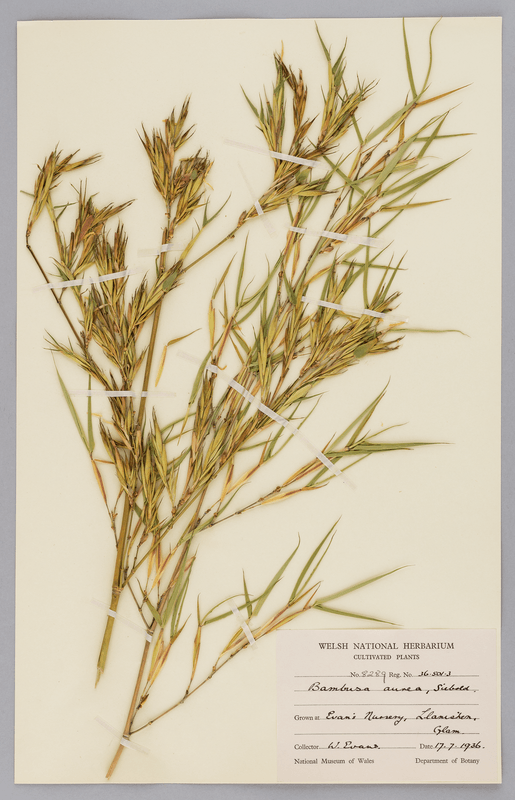Launch of the People and Plants Exhibition
, 18 February 2019
This week marks the launch of the exhibition ‘People and Plants’ in the Insight Gallery, National Museum Cardiff and accompanying public report ‘Sharing Stories, Sharing Collections.’
The exhibition and report are outcomes of a collaborative placement between the Sustainable Places Research Institute and Amgueddfa Cymru-National Museum Wales funded by the National Environment Research Council Valuing Nature Programme.
During the placement, Dr. Poppy Nicol (Sustainable Places Research Institute) spent four months within the Natural Science Department at National Museum Cardiff. Poppy worked with Principal Curator Dr. Heather Pardoe and other members of the Botany team to investigate the Amgueddfa Cymru economic botany collection and its potential role it can play in supporting, valuing and understanding of biodiversity. As part of the placement, Poppy and Heather conducted a series of workshops with community groups and interviews, with the aim of exploring how future activities associated with the economic botany collection can further societal understanding and valuing of biodiversity and address the Museum’s duty of well-being.
Drawing upon the findings of the placement, the exhibition offers insight into the Amgueddfa Cymru economic botany collection and the important role of plants in society.
Health, well-being and plants
The Amgueddfa Cymru economic botany collection includes over 5,500 specimens of medicinal plants, food products, fibres, seeds, gums, dyes and resins, most of which were acquired between the nineteenth century and present day. The selected specimens in the ‘People and Plants’ exhibition highlights the role of plants in supporting the health and well-being of past, present and future generations.
Plant-based Remedies: old and new
The economic botany collection contains over 700 medicinal plant specimens including a Materia Medica (donated by Professor Terence Turner, Cardiff School of Pharmacy and Pharmaceutical Sciences). The exhibition features a range of plant specimens used medicinally – including quinine (used for treating malaria), star anise (containing a compound used for treating influenza) and senna pods (a traditional laxative).
It also features a contemporary example of a plant-based compound for medicinal purposes – the daffodil (Narcissus pseudonarcissus). Although toxic if consumed raw, it contains galantamine which is used in the treatment of the early stage of Alzheimer’s disease.
Biocultural diversity: heritage grains
The exhibition also showcases some of the specimens within the Museum’s economic botany seed collection - which contains over 2,700 seed specimens. The collection includes a range of wheat, barley, oat and rye varieties acquired from the Welsh Plant Breeding Station. Hen Gymro, an old wheat variety affectionately known as “Old Man’s Beard” was cultivated in South Wales into the 1920’s, said to have thrived in South Wales. With predicted changing climates and the urgent need for more ecological growing approaches, perhaps some of these old grain varieties might be of value for future farmers and growers. The exhibition highlights the importance of safeguarding biodiversity – of both wild and cultivated crops and wild species.
Sharing Stories, Sharing Collections
The accompanying report to the exhibition, ‘Sharing Stories, Sharing Collections’ by Poppy, highlights how bio-cultural collections have the potential to support public understanding and valuing of biodiversity. It suggests recent legislation in the form of the Well Being of Future Generations Act (Wales) (2015) presents opportunity for Amgueddfa Cymru-National Museum Wales to become a global innovator in terms of curating bio-cultural collections.
The report identifies clear interest in the Amgueddfa Cymru economic botany collection amongst the public. It identifies a number of opportunities for innovation in bio-cultural and economic botany collections including research-driven curation; inter-generational learning programmes; and, innovative and participatory approaches to digitisation. Inter-disciplinary collaboration with other centres of learning particularly present great opportunities to share and enhance the value of the collection. Such innovations will improve the role of the collection in supporting public valuing and understanding of biodiversity and the health and well-being of future generations.
In an era where biodiversity is being eroded, bio-cultural collections have a crucial societal role of developing understanding and valuing of biodiversity through raising public awareness of the crucial role of plants in supporting livelihoods, supporting health and well-being, maintaining ecosystem services and adapting to global environmental change.
You can see the People & Plants exhibition at National Museum Cardiff until Sunday 17 March.
Read more about the start of the project in this February 2018 blog post.



Comments - (1)